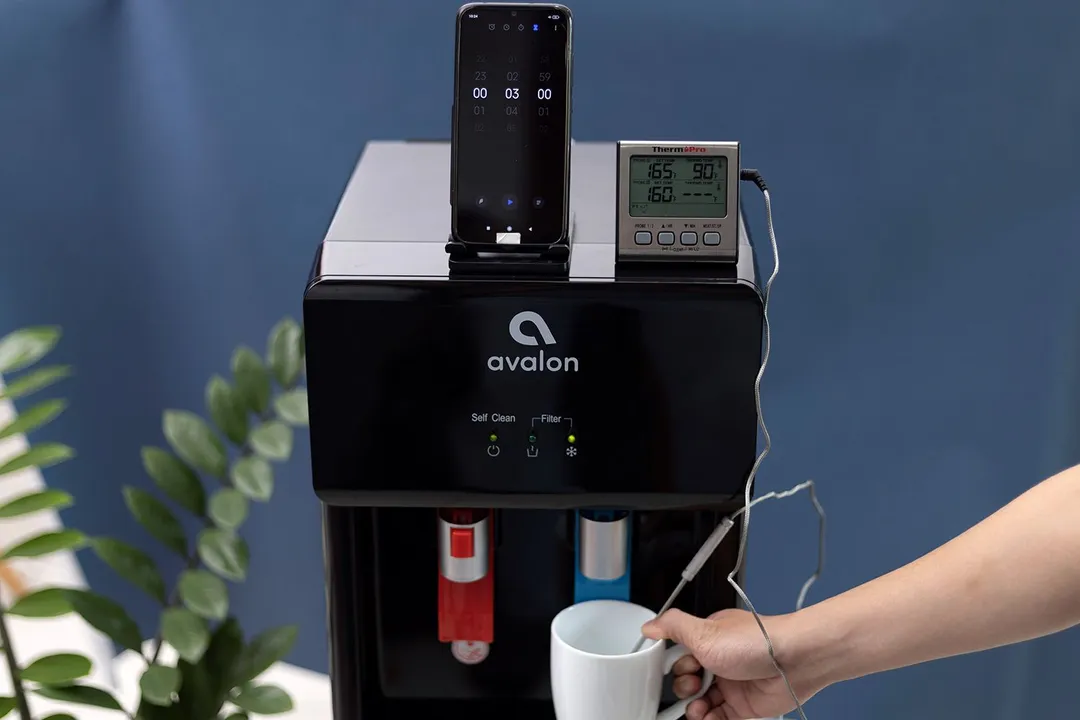Our recommendations are made independently through Research & Testing. We may receive commissions from purchases made via our links.
Hot Water Test for Water Cooler Dispensers
Find out how we test hot water from water cooler dispensers. We use these tests to rate the best performing machines for the home or office.
This test is part of Water Cooler Dispenser Test Method v1.0
Hot water performance is often overlooked when choosing a water cooler dispenser for the home or office. However, our tests highlight key things to take into account.
The first is temperature. Below, we’ll clarify the best temperature for making beverages or foods and discuss issues around hot water safety.
Next, it’s really important to know exactly how many back-to-back drinks you can get during busy times such as mornings or lunch hours. Our tests also calculate average reheating times.
Lastly, the flow rate should be moderate enough that nobody gets scalded by splashes or overflows. Conversely, if the flow is too slow, dispensing becomes a chore.
Our Hot Water Testing Procedures
We put each machine through identical tests to gauge the heating performance, flow rate, and temperature stability. From this, we also determined the single draw or back-to-back capacity and the average hourly serving capacity. Here is the procedure we follow:
- When the heating indicator turns off, we start dispensing water.
- The water flow temperature is continuously monitored and recorded.
- We stop when the temperature drops by 3℃ (5.4℉).
- Finally, we measure the volume of water released on a fluid-ounce scale.
To measure flow rates, we continually dispense water from when the heating indicator switches off (water ready) and continue until it lights up again (heater has switched on).
For better accuracy, we dispense two loads of fully heated water before testing. This is to ensure the internal temperature is stable.
Then, we continue by dispensing for up to an hour or about four to five loads of water, and do the same for a second batch test. We run a third batch on machines that deviate too widely in their results.
Finally, we do one last test for recording the flow rate and temperature on video. We also use this volume of water to determine the single daw or back-to-back capacity.
Hot Water Testing Benchmarks and Formulas
There are three major components in our test: heating time, temperature, and flow rate. Each is scored against a benchmark figure. The final hot water test score is composed of all three components, weighted as follows:
- Heating time: 35%
- Temperature: 45%
- Flow rate: 20%
Heating time benchmark:
- [10 ‒ (0.5 * Y ] : 0.5 pts subtracted for every 10 seconds slower than the benchmark.
We chose to base our ratings on the machines’ ability to heat 250 ml (8.45 fl. oz.) of water (the standard volume for a medium-sized cup) within 2 minutes. This benchmark seemed reasonable since most machines run on 420-watt heaters.
On average, a 420-watt element may take 3 minutes to boil 250 ml of water from room temperature (27℃) and 2.8 min to reach 96℃ (205 ℉).
Qt = cm(Tf-Ti)
Qt (heat); c (energy); m (mass); Tf-Ti (final-initial temp.)
Qt = 4.2J * 250ml (96℃ - 27℃) = 72 450 joules
Time = Qt / (Efficiency*Power) = 72 450 / (100%*420W) = 172.5 sec = 2.8 min
However, since not all hot water is emptied from the tank, and with residual heat helping warm the incoming water, we estimated two minutes as a reasonably high benchmark.
Temperature benchmark:
For the temperature test, we chose a benchmark temperature of 198 ℉. Most top performing machines heat water to this temperature. Once water reaches 200 ℉ and above, its properties change rapidly.
Large streaming bubbles are formed and the pressure will increase. Since a water cooler dispenser tank is a closed system, temperatures below 198 ℉ are safer for the design.
- [10 ‒ (0.5 * Y) ] : 0.5 pts subtracted for every 3.6 ℉ (2℃) deviation (Y) below the benchmark.
For a temperature of 200 ℉ or above we award 0 points as this would not be considered the safest standard. See below for discussion on ideal brewing and drinking temperatures.
Flow rate benchmark:
We found that the best flow rate for hot or cold water was 34 ml/sec (1.15 fl.oz./sec), so we chose that as an acceptable benchmark. Nozzle design is an influencing factor with faucet and lever designs having a slower flow. Button machines are generally faster.
A 34 ml/sec flow rate is neither too strong (risking splashing or overflow) nor too weak (making dispensing tedious). For scoring, we subtracted 0.5 points for each 1 ml/sec deviation above or below this baseline:
- [ 34 - (0.5 * Y) ] : 0.5 pts are subtracted for each 1 ml/sec the flow rate deviates from the baseline of 34 ml/sec.
We found little difference between flow rates for hot and cold water, so chose not to measure flow rate in our cold water test, focusing instead on different parameters.
Issues Encountered with Testing Hot Water
An inevitable problem is the performance of the machines themselves. Although testing can produce good averages, there are times when test results can differ quite a bit from one batch to another. Machines with highly variable output are generally unreliable.
With a number of models, the temperature of the water flow can fluctuate one or two degrees Celsius while dispensing. Therefore, we chose to continue dispensing until there was a 3℃ (5.4℉) drop in the flow temperature—the point where the temperature begins to decrease rapidly for almost all machines.
We initially measure the temperature in Celsius since it’s easier to track a 3℃ drop. For our video recording we measure in Fahrenheit.
After the 3℃ drop, we remove our pitcher and allow water to run off into the drip tray until the heating indicator comes on. Failing to do this can affect the output volume of subsequent tests. For some machines, the heating indicator will come on almost immediately at the 3℃ drop point.
Lastly, some hot water safety mechanisms can be cumbersome to use, especially for an extended test period. You may need to experiment with them before doing any test.
Best Temperature for Making Hot Beverages
The best hot water temperature for a water cooler dispenser depends on the purpose. Other factors may come down to design preferences and safety concerns.
The National Coffee Association recommends 195 to 205 °F (90.5‒96℃) for brewing pour-over coffee or coffee bags. The Tea Association suggests 180 to 190 °F (82‒88℃) for delicate teas such as oolong or white tea. Instant coffee such as Nescafe is best brewed at 80℃ / 176°F.
On a side note, some people may use the hot water dispenser for instant noodles. Since these are already cooked, a lower temperature simply means you must wait longer for the noodles to soften.
Safety and Hot Water Temperatures
Consumer research suggests that the best compromise between safety and consumer preference is a drinking temperature of 130 to 160 °F. Of course, this is well below the brewing temperature of a self-service appliance such as a water dispenser.
Therefore, it may be important to let your office workers know how hot the machine’s water gets.
For a young child, exposure to hot water at 140 °F can result in third-degree burns which may require hospitalization and skin grafts. For this reason, make sure the hot water safety mechanism on your dispenser is well-designed. In a customer service area, it may even be better to disable the hot water tank.
Test Developers
Roger Shitaki is a writer, author, and editor. His niches are household appliances, health & wellness, and travel. He’s a freelance contributor to a Tokyo lifestyle website and a leading ophthalmology magazine in Asia.
Lap is Head of the Research, Testing, and Review Team (RTR Team) at HealthyKitchen101.com, where he directs and supervises the testing of kitchen gadgets and appliances.
Nguyen Ntk is a graphic designer, photographer, and videographer whose philosophy centers around respecting and celebrating the beauty of reality. Through his lenses, Nguyen strives to capture the true essence of objects and events, showcasing and highlighting authentic features without distortion or exaggeration.



